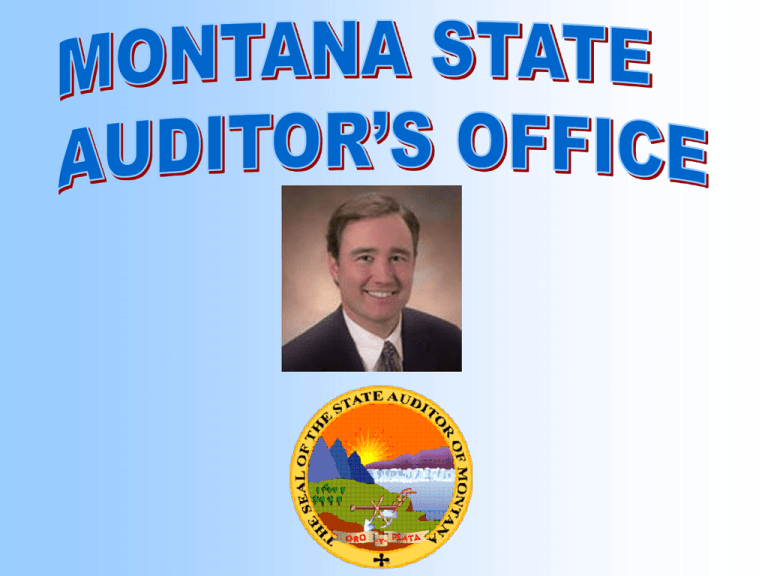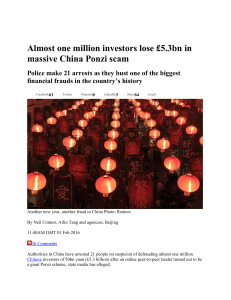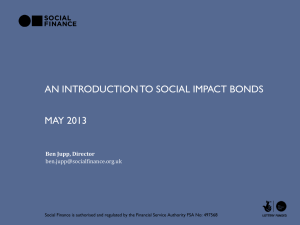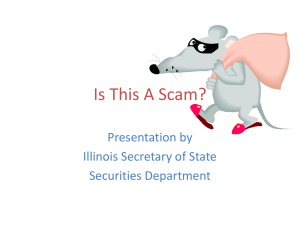Montana -Law Enforcement
advertisement

Financial Crimes Training The Typical Criminal Professional persuader, takes control of the conversation, and builds relationships with the intended victim. Appeals to the dreamer in us Brings out the worst traits in humans, particularly feeds greed. Makes people feel inadequate or stupid if they do not believe him/her. Very friendly, yet controlling. Central Registration Depository In most cases, any person who sells securities must be registered to do so. Financial professionals can be checked out on the Central Registration Depository (CRD) CRD is a computerized database that holds qualification, employment and disclosure histories of registered securities employees. Go to InvestSmart.org for link to the CRD database. Every year Montanans lose millions with a high number of victims being cheated out of their life savings and retirements. Nationally billions are lost every year to investment fraud and scams. These scams touch both the rich and poor; the sophisticated and the unsophisticated; the timid, the greedy and the elderly. What is it? A “pyramid scheme” is an illegal multi-level marketing program where the product (if there is a product) is only of secondary importance Definition - § 30-10-324(6)(a) Pyramid schemes promise big returns in a short amount of time for doing nothing but handing over money and recruiting others to do the same. How does it work? Victims make an initial investment, which gives them the right to recruit others For each person that they recruit, they receive money, gifts, or bonuses. The new recruit then makes an initial investment to get their right to recruit Money coming in from new recruits is used to pay off early investors The End Result A pyramid scheme is impossible to maintain and eventually the pyramid will collapse. The scheme gets too big and the promoter cannot raise enough money to pay earlier investors A vast majority of participants in a pyramid scheme lose all or a high percentage of their money. The promoter of a pyramid scheme can get fines up to $100,000 and 10 years in jail. § 30-10-325(2) Impossible to Sustain 16 2 36 3 216 4 1,296 5 7,776 6 46,656 7 279,936 8 1,679,616 More than Montana’s Population 9 10,077,696 10 60,466,176 11 362,797,056 More than the U.S. Population 12 2,176,782,336 13 13,060,694,016 More than the World Population What is it? “Ponzi Scheme” is named for Charles Ponzi, an Italian immigrant who made millions in the 1920’s. “Rob Peter to pay Paul” is the principle of the scheme. Definition §30-10-324(6)(b) Ponzi schemes generally involve a promoter who makes false claims about how the money is being made. Ponzi schemes differ from Pyramid schemes in that they involve a single promoter/company, unlike the Pyramids hierarchical structure. How does it work? Victims make an investment, with the promise of a high interest return on their money Promoter pays big returns to early investors using the money from later investors to help make scam seem legitimate. Statements are sent out, showing how well the company is doing. Early investors also spread the word. Promoter sits back and allows investors to find other victims. Greed feeds the scam. The End Result Eventually, the promoter runs out of investors. The scheme collapses as investors demand their money and there aren't new investments to pay them with. Early investors will make big gains but later investors will lose everything. Most of the time, the promoter will have already disappeared with a lot of the investments before the scam collapses. The promoter of a Ponzi scheme can get fines up to $100,000 and 10 years in jail. What is it? A variation of the “pyramid scheme” Also known by names such as: The Original Dinner Party, Friends Helping Friends, Airplane Club, the Ya-Ya Girls, Circle of Friends, Women empowering Women and Chain Letter Variations of the Gifting club offer a product to incoming recruits in exchange for money and then the new recruit has the right to sell the products to someone else and thereby recruit another person into the scheme. How does it work? Victims are told that the cash they invest is a gift, not taxable, and that this makes the scheme legal. Some clubs require members to sign a form stating the money is an unconditional gift. Investors recruit new people into the “club.” As new recruits are enrolled, the person at the top of the pyramid receives their “gift” and leaves the scam, so everyone moves up the pyramid and “closer to their gift” A variation has members selling a product and they turn over the profit of their first sale to the person that recruited them. The End Result Gifting Clubs are pyramid schemes. They must continually recruit ever-increasing numbers of new members to survive. When the club fails to recruit, it collapses. Or law enforcement ends the illegal activity A vast majority of participants in a gifting circle never see their big payoff , instead they lose all the money that they paid into the club to enrich a few members The promoter of a Gifting scheme can get fines up to $100,000 and 10 years in jail. What is it? No specific definition for this crime but falls under § 30-10-301(1) A scam that targets a specific group. Often the targets are religious, ethnic, or professional groups. The swindler takes advantage of the tight knit structure of the group. The criminal often makes comments that convey the basic message of “you can trust me, I’m like you.” How does it work? Affinity fraud often works with a pyramid scam, a gifting circle is especially prevalent. The scam may be based on dire predictions of the future and the need to prepare for an emergency or disaster. Group leaders are the most often targeted. Criminals will ensure that the leader receives a big payoff from the scam because the leader will begin to spread the word and entice group members to become involved in the scam. The End Result Victims of affinity fraud rarely recoup their financial damages. Emotional damage is often more excruciating as victims have been scammed by a person that they trusted. Many groups lose membership and even become defunct after a case of affinity fraud in the group. The perpetrator of Affinity fraud can get a fine of $5,000, 10 years or both - § 30-10-306(1) What is it? Mining/Precious Metals Oil and Gas Offshore Investments Promissory Notes Definition - § 30-10-202 Penalty - § 30-10-306(1) Spot the Scam Terms like “investment of a lifetime” and “high return with low risk” are used. Swindlers will often use emotion instead of facts to sway investors. The criminal avoids providing any written materials about the investment. People who sell investments must be licensed in the state of Montana to do so. Check their license Mining/Precious Metals The lure of Gold, silver, precious metals, and gems is the age-old ally of a criminal trying to persuade investors. People perceive an investment in “tangible” things, like gold and silver as safer investing. Usually involves a claim of finding an “old mine,” a untapped oil/gas resource,” or a “stockpile of gems,” Investors are warned that secrecy is key to the profits. Huge returns on the investment Short period of turnaround and a “sure thing” investment are promised. Offshore Investment Chronic in the internet era Swindlers will normally employ a shell company off shore but the investments rarely stay within the shell company for very long. Investors are told that they can avoid taxes and their money will grow faster and have a higher return. Frequently comes with some type of credit card or ATM card. Definition falls under § 30-10-301(1) Penalty - § 30-10-306 (1) Promissory Notes Sounds Simple and Safe. Investors are promised very high, even double digit returns. Criminals will try to persuade a legitimately licensed/registered producer or other professional to sell the notes for them. The notes are backed up by an insurance company that is offshore. Definition - § 30-10-202 Penalty- § 30-10-306 (1) Suspicious Activities Statement shows unauthorized activity Excessive trading and/or Churning No action is taken after talking to a manager or compliance department Broker tells investor to make checks out to a different entity or firm Investor is put into products not associated with broker or firm Reporting § 30-10-310(1) Penalty § 30-10-306(1) Law Enforcement Action Interview the victim Keep in mind that often times they will not see themselves as a victim If the victim has not sent in or transferred money attempt to talk them out of sending the money Take a detailed report and gather all documentation. If needed try to locate a family member to sit in while you talk with the victim Contact the State Auditor’s Office Securities Department 1- 800-332-6148 or 406-444-2040 Financial Crimes Training For more information or assistance, please call (406) 444-2040 or toll-free (800) 332 - 6148 State Auditor John Morrison








